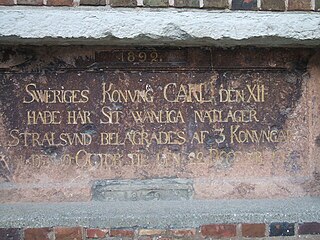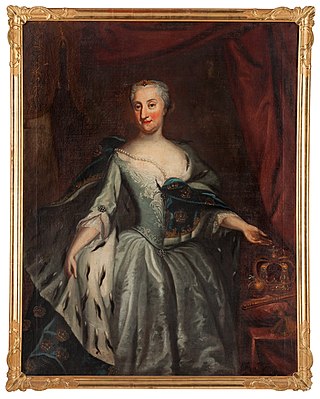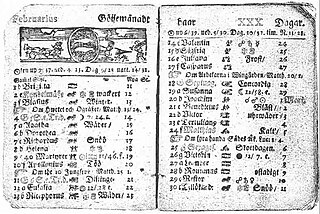| Years in Sweden: | 1712 1713 1714 1715 1716 1717 1718 |
| Centuries: | 17th century · 18th century · 19th century |
| Decades: | 1680s 1690s 1700s 1710s 1720s 1730s 1740s |
| Years: | 1712 1713 1714 1715 1716 1717 1718 |

Events from the year 1715 in Sweden
| Years in Sweden: | 1712 1713 1714 1715 1716 1717 1718 |
| Centuries: | 17th century · 18th century · 19th century |
| Decades: | 1680s 1690s 1700s 1710s 1720s 1730s 1740s |
| Years: | 1712 1713 1714 1715 1716 1717 1718 |

Events from the year 1715 in Sweden
| | This section needs expansion. You can help by adding to it. (June 2015) |

Frederick I was King of Sweden from 1720 until his death, having been prince consort of Sweden from 1718 to 1720, and was also Landgrave of Hesse-Kassel from 1730. He ascended the throne following the death of his brother-in-law absolutist Charles XII in the Great Northern War, and the abdication of his wife, Charles's sister and successor Ulrika Eleonora, after she had to relinquish most powers to the Riksdag of the Estates and thus chose to abdicate. His powerless reign and lack of legitimate heirs of his own saw his family's elimination from the line of succession after the parliamentary government dominated by pro-revanchist Hat Party politicians ventured into a war with Russia, which ended in defeat and the Russian tsarina Elizabeth getting Adolf Frederick of Holstein-Gottorp instated following the death of the king. Whilst being the only Swedish monarch called Frederick, he was Frederick I of Hesse-Kassel and thus Frederick I also of Sweden, though other Swedish monarchs with non-repeating names have not been given numerals.

Ulrika Eleonora or Ulrica Eleanor, known as Ulrika Eleonora the Younger, was Queen of Sweden, reigning in her own right from 5 December 1718 until her abdication on 29 February 1720 in favour of her husband King Frederick, and then as his consort until her death.

Charles XI or Carl was King of Sweden from 1660 until his death, in a period of Swedish history known as the Swedish Empire (1611–1721).

The Drottningholm Palace is the private residence of the Swedish royal family. Drottningholm is near the capital Stockholm. Built on the island Lovön, it is one of Sweden's Royal Palaces. It was originally built in the late 17th century, and it served as a regular summer residence of the Swedish royal court for most of the 18th century. Apart from being the private residence of the Swedish royal family, the palace is a popular tourist attraction.

Charles Frederick, Duke of Schleswig-Holstein-Gottorp was a Prince of Sweden and Duke of Schleswig-Holstein-Gottorp and an important member of European royalty. His dynasty, the Dukes of Schleswig-Holstein-Gottorp, were a cadet branch of the ancient House of Oldenburg, which at that time was ruling Denmark-Norway. His mother was a sister of Charles XII of Sweden. Charles Frederick married a daughter of Peter the Great and became the father of the future Peter III of Russia. As such, he is the progenitor of the Russian imperial house of Holstein-Gottorp-Romanov and the patrilineal ancestor of all Russian emperors starting with Peter III, except for Catherine II.

Hedwig Eleonora of Holstein-Gottorp was Queen of Sweden from 1654 until 1660 as the wife of King Charles X Gustav. She served as regent during the minority of her son, King Charles XI, from 1660 until 1672, and during the minority of her grandson, King Charles XII, in 1697. She also represented Charles XII during his absence in the Great Northern War from 1700 until the regency of her granddaughter Ulrika Eleonora in 1713. Hedwig Eleonora was described as a dominant personality, and was regarded as the de facto first lady of the royal court for 61 years, from 1654 until her death.

Strömsholm Palace, sometimes called Strömsholm Castle, is a Swedish royal palace. The baroque palace is built on the site of a fortress from the 1550s, located on an island in the Kolbäcksån river at the west end of Lake Mälaren. The palace has interiors from the 18th century and an important collection of Swedish paintings.

Ulriksdal Palace is a royal palace situated on the banks of the Edsviken in the Royal National City Park in Solna Municipality, 6 km north of Stockholm. It was originally called Jakobsdal for its owner Jacob De la Gardie, who had it built by architect Hans Jacob Kristler in 1638–1645 as a country retreat. He later passed on to his son, Magnus Gabriel De la Gardie, from whom it was purchased in 1669 by Queen Hedvig Eleonora of Sweden. The present design is mainly the work of architect Nicodemus Tessin the Elder and dates from the late 17th century.

The siege of Stralsund was a battle during the Great Northern War. The Swedish Empire defended her Swedish Pomeranian port of Stralsund against a coalition of Denmark-Norway, the Electorate of Saxony and the Tsardom of Russia, which was joined by the Kingdom of Prussia during the siege.

Countess Catherine Opalińska, was by birth member of House of Opaliński, Queen consort of the Polish–Lithuanian Commonwealth twice and Duchess consort of Lorraine through her marriage with Stanisław I of Poland.
Anna Catharina Charlotta Wilhelmina von Bärfelt, was a Swedish courtier and an influential royal favourite of Queen Hedwig Eleonora. She was immensely unpopular and rumoured to abuse her influence and position to receive bribes for influencing the queen and stealing from the royal possessions. She was convicted of theft and expelled from court.
Märta Berendes, was a Swedish Baroness and diary writer. She served as överhovmästarinna at the Swedish royal court from 1693 to 1717. She is the author of a diary written between 1676 and 1698, which has been published and has been the object of research.
Beata Sparre (1662–1724) was a Swedish courtier. She used the net of contacts her office gave her to benefit the interests of both her family, herself personally as well as individual supplicants and foreign powers in exchange for money. She is known for her successful use of her service as lady-in-waiting for lucrative purposes, and considered a notable example of a female courtier who used her office and the net of contact it gave her as a way of creating influence and personal wealth.

Charles XII is a 1925 Swedish silent historical film directed by John W. Brunius and starring Gösta Ekman, Bengt Djurberg and Augusta Lindberg. Because of its long running time of nearly six hours, it was released in two separate parts. The film depicts the life of Charles XII of Sweden (1682-1718) who oversaw the expansion of the Swedish Empire until its defeat at the Battle of Poltava. It was the most expensive production in Swedish history when it was made, and inspired a string of large budget Swedish historical films.

Events from the year 1718 in Sweden

Events from the year 1719 in Sweden

Events from the year 1713 in Sweden

Events from the year 1712 in Sweden

Events from the year 1709 in Sweden

Count Carl Gustaf Dücker was a Swedish field marshal (Fältmarskalk) and Royal Councillor.
![]() Media related to 1715 in Sweden at Wikimedia Commons
Media related to 1715 in Sweden at Wikimedia Commons